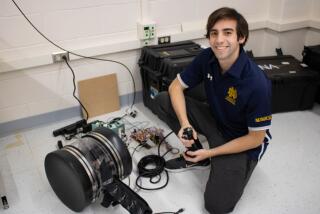Industry Offers Aid to Female, Minority Engineering Hopefuls
- Share via
When college friends ask Wendy Power and Darius Sankey what they do when they are not in school, their answer is: Build communications satellites.
Their work is part of an unusual scholarship program sponsored by Hughes Aircraft Co. that helps women and minorities become engineers.
With the U.S. Labor Department predicting that the need for electrical and electronic engineers will rise from a total of 390,000 in 1984 to 597,000 in 1995, “the supply of engineering graduates, especially women and minorities, will not be able to equal the demand,” program director Elaine Harrell said.
Added Albert Wheelan, chairman-elect of Hughes, who persuaded the company to establish the scholarships in 1972: “It seemed to me that business was losing out by simply competing for the relatively small number of minority and female graduates without contributing to the overall supply. We recognized that we needed to work on the problem from the other end--to help with education for those with the will but without the resources.”
“A lot of people simply can’t afford to go to a good college and get a good education in order to work at a company like Hughes,” said Sankey, a 20-year-old junior at Massachusetts Institute of Technology. He is one of more than 75 people who have participated or are currently enrolled in the company’s Special Engineering Student Scholarship Program.
Students chosen get a scholarship of up to $2,100 a year toward the cost of their engineering studies, Harrell said. During the summer, students work with teams of Hughes engineers, helping design and build the high-technology electronics equipment the company makes for military, scientific and commercial use.
For this work, they are paid at the same rate as regular employees, depending on their experience. All year long, they receive company medical benefits and can get advice on courses and financial problems from the company, Harrell said.
Once in the program, students must maintain a 3.0 grade average, Harrell said. She added that most of them have much higher averages.
Criteria for selection, she said, include grade point average, scholastic aptitude scores, participation in extracurricular activities, recommendations from school and community representatives, and financial status.
“We are not looking for students who want to go to college to discover themselves,” Harrell said. “We’re looking for students who know where they want to go.”
One such student is 20-year-old Power, a junior who is studying aerospace engineering at MIT. “My goal is to get into the control aspect of satellites and movement in space. I’d also like to get into robotics,” she said.
During her first two summers at Hughes, Power helped engineers put together a prototype of a new brain for the Itelsat VI satellite, which provides commercial communications worldwide. Last summer, she assisted in writing the computer instructions for satellite motor-control systems.
“It was a good overall experience,” she said. “Sometimes I was actually getting under the satellite shell with a screwdriver; other times I helped engineers with blueprints. It’s fun, but it’s real research too.”
Sankey agreed. “Getting real work experience is important,” he said. “Most engineering companies these days want to hire people with experience as well as with a bachelor’s degree.”
Sankey joined the program the summer before he entered MIT and is a veteran of three summers at Hughes. During that time he has helped develop computer programs that activate satellite communications systems, learned orbital mechanics and assisted in developing a proposal to use radar to map the surface of Venus.
When students graduate, they are not obligated to work for the company and the company is not obligated to hire them, Harrell said. But, so far, more than half of them have become staffers.
One is Ruth Ramos, 25, who said she had dreamed about being an engineer since high school. But, as the daughter of a Mexican immigrant who now works as an assembler in Los Angeles, she doubted that she would be able to fulfill her dream.
“My dad had a hard time believing it, even two years after I was in college,” she said. “He kept asking me, ‘Are you really going to be an engineer?’ ”
Today she is one.
With her bachelor of science degree in engineering in hand, Ramos is helping design radar-transmitter control systems for satellites.
More to Read
Inside the business of entertainment
The Wide Shot brings you news, analysis and insights on everything from streaming wars to production — and what it all means for the future.
You may occasionally receive promotional content from the Los Angeles Times.










